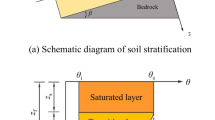Abstract
Researchers have found that changes in infiltration characteristics that result from surged flow, often inferred from advance trajectories, vary considerably with site and management practices. Previously developed methods for adjusting the infiltration function for the surged effect are examined to better understand these effects. The easily implemented cycle ratio-time (CRT) surged flow infiltration function indicates that soil and management factors can impact surged flow effectiveness. If changes in flow rate result in changes in the on/off pulse patterns, the CRT function will reflect this with changes in infiltration characteristics; otherwise the model is insensitive to changes in flow rate. The duration of the first surge has a more pronounced effect than later surges, and soils that reach steady state infiltration quickly are less likely to exhibit decreased infiltration rates as a result of surged flow. Surged flow simulation runs are used to show that the CRT function predicts differences in performance on opposite sides of tee-type surge valves; the result of uneven off-times associated with expanding cycle times.
Similar content being viewed by others
References
Allen NL (1980) Advance rates in furrow irrigation for cycled flow. M.S. Thesis. Utah State University, Logan, Utah
Bishop AA, Walker WR, Allen NL, Pool GJ (1981) Furrow advance rates under surge flow systems. J Irrig Drainage Engr ASCE, 07(IR3):257–264
Blair AW, Smerdon ET (1987) Modeling surge irrigation infiltration. J Irrig Drainage Engr ASCE, 113(4):497–515
Coolidge PS, Walker WR, Bishop AA (1982) Advance and runoff surge flow furrow irrigation. J Irrig Drainage Engr ASCE, 108(IR1):35–41
Eisenhauer D, Frank KD, Dickey EC, Fischbach PE, Wilhelm W (1984) Tillage practice effects on water conservation and the efficiency and management of surface irrigation systems. Project Completion Report. B-057-NEB. Universtiy of Nebraska-Lincoln
Izuno FT, Podmore TH (1985) Kinematic wave model for surge irrigation research in furrows. Trans. of the ASAE, 28(4):1145–1159
Izuno FT, Podmore TH, Duke HR (1985) Infiltration under surge irrigation. Trans ASAE, 21:517–521
Kemper WD, Trout TJ, Humpherys AS, Bullock MS (1988) Mechanisms by which surge irrigation reduced furrow infiltration rates in a silty loam soil. Transactions of the ASAE 31(3):821–829
Killen MA, Slack DC (1987) Green-Ampt model to predict surge irrigation phenomena. J Irrig Drainage Engr. ASCE, 113(4):575–584
Lep DM (1982) An investigation of soil intake characteristics for continuous and intermittend ponding. M.S. Thesis. Utah State University, Logan, Utah
Pitts DJ, Ferguson JA (1985) A comparison of surge and continuous flow furrow irrigation on clay soil with flat grade. ASAE Paper No. 85-2584
Podmore TH, Duke HR (1982) Field evaluation of surge irrigation. ASAE Paper No. 82-2102
Podmore TH, Duke HR, Izuno FT (1983) Implementation of surge irrigation. ASAE Paper No. 83-2018
Purkey DR, Wallender WW (1989) Surge flow infiltration variability. Trans ASAE, 32(3):894–900
Rogers DH, Lamm FR (1984) Surge flow irrigation experiences. ASAE Paper No. MCR84-151
Saleh A, Hanks RJ (1989) Field evaluation of soil hydraulic property changes caused by surge water application. Soil Sci Soc Am J 53:1526–1530
Samani ZA, Walker WR, Willardson LS (1985) Infiltration under surge flow irrigation. Trans the ASAE, 28(5) 1539–1542
Segeren AG, Trout TJ (1991) Hydraulic resistance of soil surface seals in irrigated furrows. Soil Sci Soc Am J 55:640–646
Strelkoff T (1990) SRFR — A computer program for simulating flow in surface irrigation, furrows-basins-borders. WCL Report No 17. U.S. Water Conservation Laboratory. Phoenix, AZ
Strelkoff T (1993) Flow simulation for surface irrigation design. In: Allen R, Neale M (ed) ASCE Management of Irrigation and Drainage Systems, Integrated Perspectives
Testezlaf R, Elliott RL, Garton JE (1987) Furrow infiltration under surge flow irrigation. Trans ASAE, 30(1):193–197
Walker WR, Humpherys AS (1983) Kinematic wave irrigation model. J Irrig Drainage Engr ASCE, 109(IR4):377–392
Westesen G, Biglen D (1986) Surge flow border irrigation summary. Western Region Research Committee — Surge Flow Irrigation. Phoenix, Arizona, Jan 1986
Yonts CD, Eisenhauer DE (1991) Impact of surge irrigation on furrow water advance. ASAE Paper No. 91-2125
Yonts CD, Eisenhauer DE, Cahoon JE (1991) Application of Surge Irrigation. NebGuide G91-1017, Nebraska Cooperative Extensive Service
P & R Surge Systems, Inc. Product information. 327 E. 40th, P.O. Box 3361, Lubbock, TX 79452
Waterman Industries, Inc. Product information. P.O. Box 458, Exeter, CA 93221
Author information
Authors and Affiliations
Rights and permissions
About this article
Cite this article
Cahoon, J., Eisenhauer, D. Inferences of the cycle ratio-time surged flow infiltration function. Irrig Sci 15, 173–182 (1994). https://doi.org/10.1007/BF00193685
Received:
Issue Date:
DOI: https://doi.org/10.1007/BF00193685




